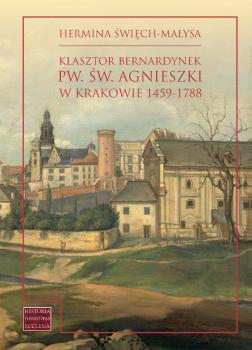Klasztor bernardynek pw. św. Agnieszki w Krakowie: 1459-1788
Keywords:
Bernardine Sisters, St Agnes Convent, CracowSynopsis
The purpose of this work is to present the history of the first Bernardine nunnery on Polish soil, bearing the name of St Agnes, once located in Cracow, in the suburb of Stradom, near the so-called Royal Bridge. The fate of the nuns living there for more than three centuries was inextricably linked with the history of the city and the local Church. The year 1459 marks the beginning of the work, when, on the initiative of the generous founder and benefactor Jan Hińcza from Rogów, the erection of the temple and the first monastery buildings began. It should be noted, however, that the genesis of their community is somewhat earlier and is closely linked to the stay of St John of Capistrano in Cracow. It was under the influence of his fiery sermons and the power of his influence that groups of pious women had hitherto gathered from below to lead a community life near the monastery of the brothers. The end date of the dissertation is 1788, when, on the initiative of Primate Michał Poniatowski, who at the same time held the office of administrator of the Cracow bishopric, the convent of St Agnes was dissolved and the Bernardines were forced to move to the St Joseph’s convent, located on the present Poselska Street. Structurally, the work consists of five chapters. The first chapter presents the origins of the community of Bernardine nuns, closely linked tothe preaching activity of St John of Capistrano. The original seat of the Tertiaries, which was located in a house at Mikołajska Gate, is discussed. It is presumed that it was its inhabitants who, after moving to the suburb of Stradom, became the nucleus of the future community of the St Agnes Convent. The next part of the chapter discusses Jan Hińcza from Rogów, the founder of the monastery and church, and the stages of the temple’s construction. The external appearance of the monastery’s church is presented, based on preserved written and iconographic sources, with an emphasis on the caesura represented by the invasion of the Swedish army, which contributed to the total destruction of the original establishment, forcing the nuns to wander and seek temporary shelter. The reconstruction process and the contribution made in this field by the superiors of the Bernardine convent are then discussed. The furnishings of the monastery church and its sacristy are presented on the basis of the preserved inventories written as a result of the visitations carried out by the provincials of the Order of Friars Minor Observant. The last part of the chapter is devoted to the subject of the suppression, carried out in 1788 following the inspiration of Primate Michał Poniatowski.
Chapters
-
TABLE OF CONTENTS
-
WSTĘP .......... 9
-
I. FUNDACJA KLASZTORU I KOŚCIOŁA PW. ŚW. AGNIESZKI W KRAKOWIE I JEGO KASATA W 1788 R.
-
1. Geneza wspólnoty bernardynek w Krakowie .......... 25
-
2. Powstanie klasztoru i kościoła pw. św. Agnieszki .......... 38
-
3. Kasata klasztoru .......... 90
-
II. PRZEPISY PRAWNE REGULUJĄCE FUNKCJONOWANIE KLASZTORU
-
1. Reguła Trzeciego Zakonu św. Franciszka zatwierdzona przez papieża Mikołaja IV .......... 103
-
2. Ustawy papieskie nadane przez o. Gabriela Rangoniego z Werony i inne ustawy przedtrydenckie .......... 111
-
3. Reforma potrydencka .......... 127
-
4. Uchwały kapituł bernardyńskich i prawne odniesienia do bernardynów .......... 152
-
III. ŻYCIE W KLASZTORZE
-
1. Rekrutacja do klasztoru .......... 168
-
2. Etapy życia klasztornego .......... 230
-
3. Wydarzenia nadzwyczajne .......... 259
-
IV. ORGANIZACJA WEWNĘTRZNA KLASZTORU I ŻYCIE DUCHOWE
-
1. Urzędy klasztorne .......... 297
-
2. Familia klasztorna – rezydentki i służba .......... 356
-
3. Spowiednicy i kapelani .......... 360
-
4. Duchowość .......... 388
-
V. ŹRÓDŁA UTRZYMANIA KLASZTORU
-
1. Sposób zarządzania sprawami gospodarczymi .......... 419
-
2. Dochody stałe .......... 428
-
3. Dochody jednorazowe .......... 445
-
4. Wydatki .......... 458
-
ZAKOŃCZENIE .......... 465





